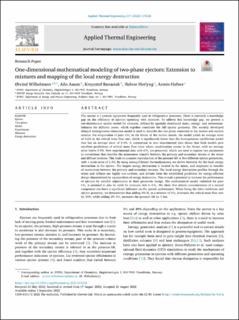| dc.contributor.author | Wilhelmsen, Øivind | |
| dc.contributor.author | Aasen, Ailo | |
| dc.contributor.author | Banasiak, Krzysztof | |
| dc.contributor.author | Herlyng, Halvor | |
| dc.contributor.author | Hafner, Armin | |
| dc.date.accessioned | 2023-01-19T08:36:43Z | |
| dc.date.available | 2023-01-19T08:36:43Z | |
| dc.date.created | 2022-09-23T16:12:17Z | |
| dc.date.issued | 2022 | |
| dc.identifier.citation | Applied Thermal Engineering. 2022, 217 . | en_US |
| dc.identifier.issn | 1359-4311 | |
| dc.identifier.uri | https://hdl.handle.net/11250/3044462 | |
| dc.description.abstract | The ejector is a process equipment frequently used in refrigeration processes. There is currently a knowledge gap on the efficiency of ejectors operating with mixtures. To address this knowledge gap, we present a one-dimensional ejector model for mixtures, defined by spatially distributed mass-, energy- and momentum-balances for different zones, which together constitute the full ejector geometry. The recently developed delayed homogeneous relaxation model is used to describe the two-phase transition in the motive and suction nozzles. For evaporation of pure in the throat of the motive nozzle, the model yields an average error of 2.6% in the critical mass flow rate, which is significantly lower than the homogeneous equilibrium model that has an average error of 8.4%. A comparison to new experimental data shows that both models give excellent predictions of critical mass flow rates where condensation occurs in the throat, with an average error below 0.9%. New experimental data with are presented, which are used to regress two parameters in correlations that describe the momentum transfer between the primary and secondary stream in the mixer and diffuser sections. This leads to accurate reproduction of the pressure lift in five different ejector geometries, with a mean error of 2.3%. By using nonequilibrium thermodynamics, we derive formulae for the local exergy destruction in the ejector. The largest exergy destruction is located in the mixer, and originates in transfer of momentum between the primary and secondary streams. The local exergy destruction profiles through the mixer and diffuser are highly non-uniform, and deviate from the established guidelines for energy-efficient design characterized by equipartition of exergy destruction. This reveals a potential to increase the performance of ejectors by suitable adjustments to their geometric design. The mathematical model validated for pure is assumed to also be valid for mixtures rich in . We show that minute concentrations of a second component can have a significant influence on the ejector performance. When fixing the inlet conditions and ejector geometry, we demonstrate that adding 2% to a mixture of decreases the critical mass flow rate by 20%, while adding 2% increases the pressure lift by 1 bar. | en_US |
| dc.language.iso | eng | en_US |
| dc.publisher | Elsevier Science | en_US |
| dc.rights | Navngivelse 4.0 Internasjonal | * |
| dc.rights.uri | http://creativecommons.org/licenses/by/4.0/deed.no | * |
| dc.title | One-dimensional mathematical modeling of two-phase ejectors: Extension to mixtures and mapping of the local exergy destruction | en_US |
| dc.title.alternative | One-dimensional mathematical modeling of two-phase ejectors: Extension to mixtures and mapping of the local exergy destruction | en_US |
| dc.type | Peer reviewed | en_US |
| dc.type | Journal article | en_US |
| dc.description.version | publishedVersion | en_US |
| dc.source.pagenumber | 12 | en_US |
| dc.source.volume | 217 | en_US |
| dc.source.journal | Applied Thermal Engineering | en_US |
| dc.identifier.doi | 10.1016/j.applthermaleng.2022.119228 | |
| dc.identifier.cristin | 2054962 | |
| dc.relation.project | EU – Horisont Europa (EC/HEU): 84213 | en_US |
| cristin.ispublished | true | |
| cristin.fulltext | original | |
| cristin.qualitycode | 1 | |

